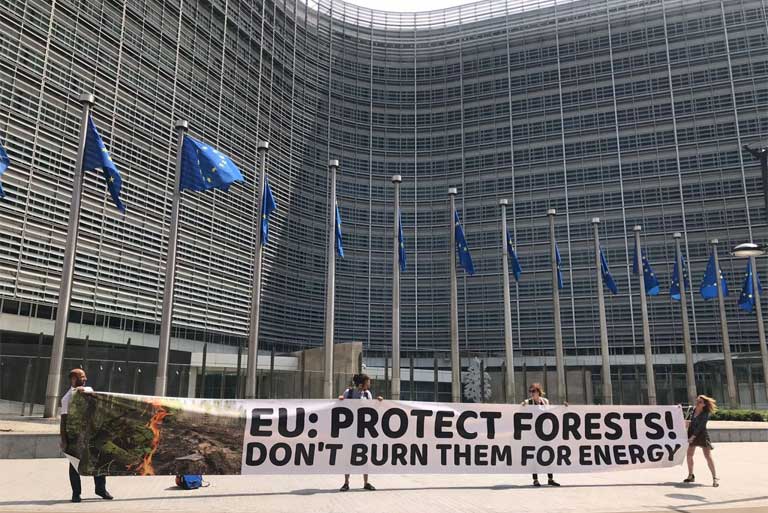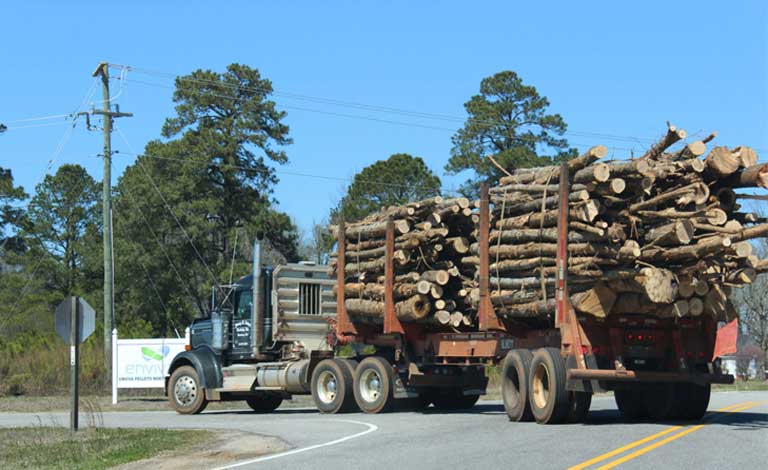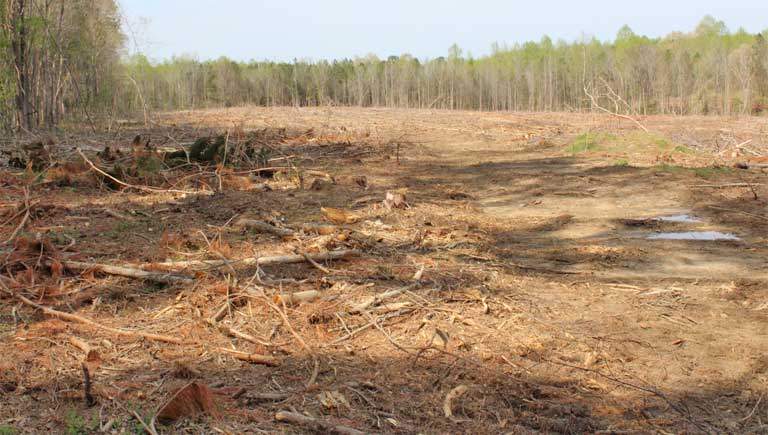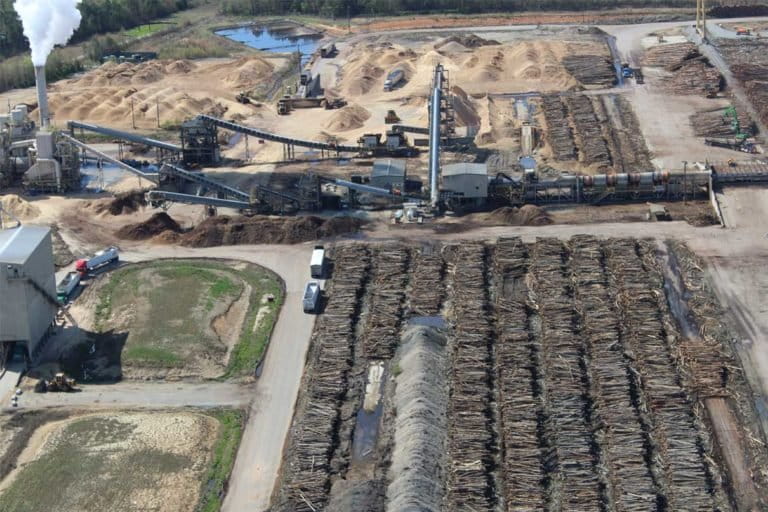- EU officials are currently working to finalize REDII renewable energy policy revisions and amendments by mid-July for EU parliamentary review. One component of that review is to determine whether forest biomass burning will continue to be considered carbon neutral by the 27 EU member states.
- Current science is clear: burning forest biomass to make energy is not carbon neutral, and the burning of wood pellets is dirtier per unit of electricity than burning coal. But the forestry industry and EU continue defending biomass, prompting an open letter from forest advocates harpooning the policy.
- In the leadup to the updated REDII policy revision proposals, European Commission Exec. VP Frans Timmermans says he truly values forests, but simultaneously believes that cutting them down and burning them to make electricity remains viable climate policy. More than 50% of the EU’s current wood harvest is being burned for energy.
- “Ecocide threatens the survivability of our forests. I certainly don’t underestimate the challenges we face, but still, I believe [burning forest] biomass can play a very useful role in the energy transition,” says Timmermans.
“Please get the science right,” forest advocates implored last week in an open letter sent to the most influential European Commission leader on climate, as the European Union reevaluates its renewable energy policies this month.
That letter comes at a crucial moment which will determine whether the continent hits its ambitious voluntary carbon-reduction target under the Paris Agreement, and also whether it does so without relying on an existing EU carbon reporting loophole that allows the burning of forest biomass to make electricity, with the resulting greenhouse gas releases counted as generating “zero emissions.”
The June 7 letter posted by the global Forest Defenders Alliance, is part of an intensifying campaign putting pressure on Frans Timmermans, European Commission executive vice president. Timmermans role is manyfold: he is the EU’s point person on its European Green Deal, the lead on its Biodiversity Strategy, on setting the EU’s 55% carbon-emission reduction target by 2030, and in this case, reviewing the Renewable Energy Directive (RED II) as it pertains to burning and subsidizing woody biomass for energy and heat.

To date, activists are concerned over Timmermans’ hedging regarding RED II forest biomass burning to make electricity.
In mid-May, a half dozen forest advocates pressed Timmermans during an hour-long virtual call regarding forest ecology, the importance of protecting Europe’s remaining intact forests and biodiversity, and the hazards of substituting wood pellets for coal as a climate solution. (Wood is dirtier than coal per unit of electricity made, and is not carbon neutral according to scientists, a finding which contradicts forest industry claims.)
Later, Timmermans appeared to contradict himself in an interview with Euractiv, a European news agency, which prompted the open-letter response. While defending forests during that interview, Timmermans also promoted the burning of biomass; advocates say he can’t have it both ways. The biomass industry harvests tens of thousands of hectares of intact forests annually in regions including the U.S. Southeast, western Canada and across Europe to meet a surging demand for wood pellets among the 27-nation EU.


That wood, long classified as a renewable energy resource on par with zero-carbon wind and solar, is being burned instead of coal. Under that definition, wood pellet carbon emissions are not counted at the smokestack, thus giving member countries an on-paper-only emissions reduction under EU law.
“We know you want to do the right thing on climate and ecosystem restoration, but you’re scaring us, because your recent statements… suggest you’re still not clear on certain key principles around forests and biomass energy,” says the open letter which was drafted by ecologist Mary Booth, director of the Partnership for Policy Integrity. “We need policymakers to treat climate change and ecosystem restoration with the seriousness they’d treat national defense or terrorism,” the letter states.
Instead, Booth wrote, “this whole biomass thing” comes across as being merely inconvenient, “instead of posing an existential threat to the EU’s forests and hopes for climate mitigation.”
A spokesperson for Timmermans declined to answer direct questions from Mongabay, adding that a response to the letter is possible but may not be made public. The spokesperson said REDII revisions and amendments will be ready for EU parliamentary review by mid-July.

Pressure from all sides seems to evoke mixed message
Timmermans isn’t only being pressed by environmentalists; he’s also being lobbied by wood-producing countries and a multibillion-dollar biomass industry that says it uses mainly forest residue and mill waste to make millions of tons of pellets annually. Bioenergy advocates also argue they are committed to protecting forests, fighting climate change and “sustainably” managing intact forests so that their logging does not adversely impact carbon stocks.
But drone views of pellet-making plants put those claims in doubt, as they show massed stacks of entire trees — former carbon-storing forests and habitat — awaiting processing into pellets. Environmental NGOs have also tracked trucks loaded with logs, moving from clear cuts to wood pellet plants.
Timmermans does appear more aware now of the controversial issues involving biomass than he did when questioned by Mongabay at COP25 in 2019. But as yet, he and EU officials remain unwilling to commit to the degree of forest protections scientists say are urgently required now to enhance carbon sequestration, slow the rate of climate change, and prevent catastrophic global warming.
EU wood pellet demand will have doubled from 4.5 million tonnes in 2017 to 9 million tonnes according to projections by the Environmental Paper Network.

Timmermans’ own words appear to show how conflicted he remains on the topic — even as global evidence indicates that deforestation is accelerating, carbon emissions and temperatures are rising apace, climate impacts are worsening, and government interventions remain severely insufficient to address the crisis.
In the EU’s push to require renewable energy to reduce emissions, it now gets 60% from biomass, the vast majority from burning wood. Timmermans told Euractiv, “Well, without biomass, we’re not going to make it,” meaning possibly that the EU will fail to meet its renewable energy mandates. “We need biomass in the mix, but we need the right biomass in the mix. I hate the images of whole forests being cut down to be put in an incinerator. I think it’s unsustainable and indefensible.”
Booth countered by saying that the EU’s on-paper renewable energy target is not what matters in climate change mitigation. Rather, it’s hitting the real-world carbon-reduction target that matters: “Burning forest biomass emits more CO2 at the smokestack or chimney than burning fossil fuels, per unit of energy, so right off the bat, something miraculous needs to happen for forest biomass to ‘reduce’ emissions, except on paper.”


Helping forests by logging them?
Timmermans also roughly cited a line favored by the biomass industry: “I believe that in primal forests, if you maintain them, there’s always a lot of biomass that you can take out — you even help the forest by doing that.”
“This is really alarming,” Booth wrote, pointing out Timmermans’ error. “Primary forests… by definition mean forests that are not logged or managed. Then you say logging ‘helps’ manage unmanaged forests. We are sure you did not mean to contradict the EU’s own Biodiversity Strategy, which aims for ‘strict protection of all primary and old-growth forests in the EU.’ Please – walk this back. We can’t even imagine the high-fives going on by the biomass industry when they read that!… Can you get some real forest ecologists as close advisers? Logging does not ‘help’ forests.”
Of the millions of tons of wood pellets burned annually in the EU, forest advocates estimate that about half comes from natural forests. At a minimum, the Forest Defenders Alliance is calling for RED II to be revised to ban the harvest and pelletizing of roundwood trees from within forests brimming with biodiversity, and the limiting of woody biomass for burning to wood waste alone.
EU members including Finland, Sweden, Lithuania and Latvia are biomass providers, often clearcutting their primary forests; they are pushing back against such changes to REDII.
For their part, biomass advocates want biomass to remain classified as a renewable energy source and seen as a climate solution. Christian Rakos, president of the World Bioenergy Association, explained to Mongabay earlier this year:
“We understand that there are worries that bioenergy could lead to unsustainable practices given the size of the energy market, if no safeguards are in place to ensure sustainability. Our position is to do everything possible to ensure sustainability but to keep in mind that climate change is the greatest threat to ecosystems at present and that it will be impossible to mitigate it without extensive use of bioenergy.”

‘Not carbon neutral, per se’
The most vexing and contentious forest biomass controversy stems from the classification of wood pellet burning as being carbon neutral.
According to REDII and the biomass industry, emissions from wood pellets are immediately zeroed out by new trees planted elsewhere. But a range of studies have shown that it takes newly planted trees decades or more to offset biomass burned today — time that neither the planet nor humanity has to drastically curb climate change, according to the U.N. Intergovernmental Panel on Climate Change.
When asked if EU law regarding carbon neutrality needed to change, Timmermans responded, “Biomass is not considered carbon neutral per se, but the accounting is different. You don’t count the carbon when you burn it; you account for the carbon at production, where it grows.”
Timmermans’ statement, while accurate on paper, does not matter to nature. The science is clear: burning forest biomass for heat and energy adds carbon to the atmosphere at the smoke stack, regardless of accounting methods, thus undercutting carbon-reduction goals while further contributing to climate change.
“We’re glad you agree that biomass isn’t carbon neutral, but we’re puzzled why you think using a technology that you admit isn’t carbon neutral is going to help the EU become carbon neutral,” Booth wrote. Europe’s “own scientists admit that burning forest biomass increases emissions compared to fossil fuels for decades to centuries. How does [that] reduce emissions?”


‘Dear VP Timmermans’
In another example of Timmermans’ seeming conflicted thinking, he told Euractiv: “Let’s be clear: 75% of our forests are in bad shape. We have a huge biodiversity challenge. Ecocide threatens the survivability of our forests. I certainly don’t underestimate the challenges we face, but still, I believe biomass can play a very useful role in the energy transition.”
Booth responded: “Dear VP Timmermans, we love you for using the word ‘ecocide’ because it’s how we know you’re sincere about wanting to restore ecosystems and save the climate. We just wish you’d see the connection between forest ecosystem [devastation] and carbon-sink degradation, exploding growth in [national] biomass subsidies, and more than 50% of EU wood harvest now being burned for energy.…
“Only one thing will help restore forests and the carbon sink: stop counting [forest] biomass toward renewable energy targets, and stop allowing [EU] Member States to subsidize burning forest wood. It’s simple, and it’s science-based.”
Booth told Mongabay that the options the EU is considering for revising REDII predominantly promote business as usual, with only one option offering to limit — not eliminate — cutting intact forests to make wood pellets.
With the biomass industry gearing up to expand wood pellet production on a massive scale to meet soaring “clean” energy demand across Europe and Asia, Booth said she and a host of forest advocates will continue arguing the case against burning trees to make electricity in the lead-up to the United Nations climate summit in Scotland in November (COP26), and especially if revisions to REDII provide no real change.
“We’re not going away,” Booth said. “We know this is a long-term play. We’re going to be their worst nightmare in the years ahead.”
Justin Catanoso, a regular contributor to Mongabay, is a professor of journalism at Wake Forest University in North Carolina. Follow him on Twitter @jcatanoso
Banner image: Frans Timmermans. Photo credit: European Parliament on VisualHunt
FEEDBACK: Use this form to send a message to the author of this post. If you want to post a public comment, you can do that at the bottom of the page.
